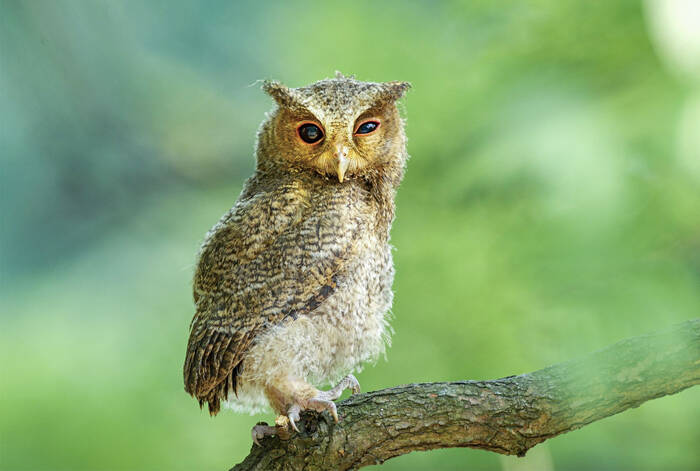Otus lettia
IUCN
LCBasic Information
Scientific classification
- name:Otus lettia
- Scientific Name:Otus lettia,Collared Scops Owl
- Outline:Raptor
- Family:Strigiformes Strigiformes Owl
Vital signs
- length:23-25cm
- Weight:100-170g
- lifetime:5-7years
Feature
The facial disc is dark yellow with some dark concentric spots
Distribution and Habitat
Distributed in Bangladesh, Bhutan, Cambodia, China, India, Indonesia, Laos, Malaysia, Myanmar, Nepal, Pakistan, Thailand and Vietnam.
From the eastern Himalayas, from eastern Nepal to Assam, south to eastern Bangladesh, Myanmar, Thailand, southern China (including Hainan Island and Taiwan Island).
The scops owl inhabits forests, shrubs, secondary forests, and woods and bamboo forests around open villages and towns. The habitat altitude ranges from plains to mountains with an altitude of about 2,400 meters.
Appearance
The scops owl is 23-25 cm long, with a wing length of 158-188 mm. The tail is 75-102 mm long and weighs 100-170 g. Females are usually larger and heavier than males. The facial disc is dull yellow with some dull concentric spots.
The upper body is mottled light yellowish brown with spots and freckles, with black and light yellow, and light grayish yellow (gray-brown variant) or tan-yellow (reddish brown variant). There are pale yellow feathers on the shoulder blades, forming a faint stripe on the wings. There are two light-colored collars on the back of the neck.
The underparts are light brown with small arrow-shaped shaft stripes. The species has feathers at the base of the toes, which are flesh-gray to dark olive with yellow-white pads. The claws are the same color as the toes.
The iris is dark brown to orange-brown. The bill is horny green with a lighter tip. The lower jaw is pale yellow.
Details
Collared Scops Owl, also known as Collared Scops Owl, is a small bird with 5 subspecies.

The breeding season for the scops owl is from February to May. The nest is built in a natural hollow, in a woodpecker hole in a tree trunk or dead stump. Most of them are at a medium height of about 2-5 meters or higher. Usually 3-4 eggs are laid per nest, sometimes 5, averaging 32.3×28 mm.
On the morning of May 15, 2022, people in Penghu Town, Yongchun County saw a cute baby bird on the ground in the rain. They picked it up and sent it to the Penghu Police Station for help. The police station then transferred the baby bird to the Yongchun County Wildlife Rescue Station. The staff confirmed that the baby bird was a collared scops owl, an owl of the genus Owl and the family Strigiidae, and a national Class II protected animal.
Listed in the "Red List of Endangered Species of the World Conservation Union" (IUCN) 2016 ver3.1-Least Concern (LC).
Listed in Appendix I, II and III of the Convention on International Trade in Endangered Species of Wild Fauna and Flora (CITES) 2019 Edition Appendix II.
Listed in China's National List of Key Protected Wildlife (February 5, 2021) Level II.
Protect wildlife and eliminate game.
Maintaining ecological balance is everyone's responsibility!








